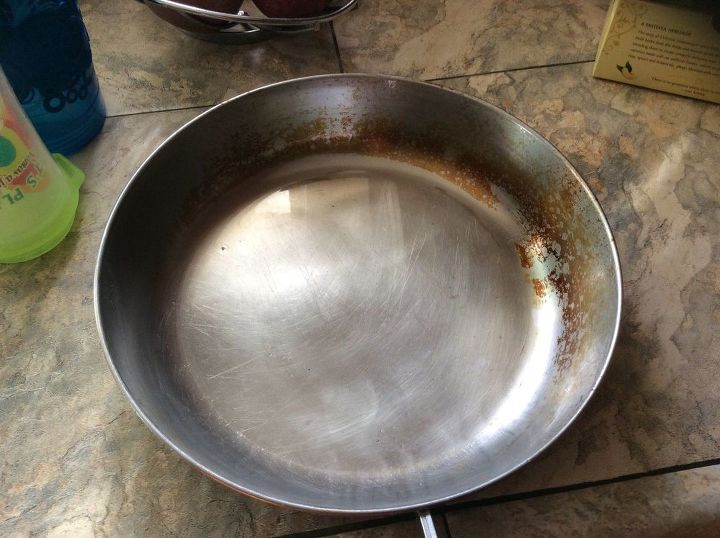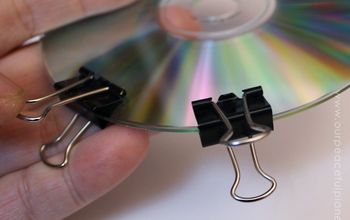How do u make a face shield ?
Make a plastic shield for the face ?
Related Discussions
How to clean a mirror without streaks?
Every time I clean my mirrors, they end up having tons of streaks and almost look worse than before I started. What could I use to clean them that won't leave streaks... See more
How to clean burns on stainless steel pans?
Help! I burned my pan. How do I clean stainless steel cookware that's been burned?
How to clean shower doors
How to clean glass shower doors
How to clean hardwood floors in the kitchen?
What is the best way to clean hardwood floors in the kitchen?
How to clean my kitchen cabinets from grease?
My kitchen cabinets are embarrassingly greasy. Please share your degreasing tips with me so I don't have to cringe every time I glance at my cabinets.
How to kill flies with out harming my indoor rabbits.
I have 50 bunnies that live indoors. They all live in hutches. They are cleaned out religiously 2 times a week in the winter and everyday in the summer. Flies can be... See more
How do I clean a rusty bathtub?
There are several metallic stains and other stains that bleach and lime remover don't remove. Part of the ceramic coat is gone! Any help, please. I'm sure my landlord... See more




Hi there you could check out this video. https://www.youtube.com/watch?v=VYpXH7tlPzY
Hi Kathy, Here is a great video on how to make them... https://www.youtube.com/watch?v=v9FSDSc76q4
Hi Kathy, Here is a great video on how to make them... https://www.youtube.com/watch?v=v9FSDSc76q4
Kathy: even if you make a plastic face shield, you should ALSO wear a mask under it! (Look at doctors!)
https://hellosewing.com/homemade-plastic-face-shield/
Here is a video on how to make a face shield: https://www.youtube.com/watch?v=v9FSDSc76q4
Although shields work well in certain circumstances, a mask is still needed. Safety glasses are another way to protect your eyes. A good, snug pair will serve that purpose. As a retired nurse, I can tell you you that we only wore them for close procedures that involved body fluids that might splash, like suctioning or wound cleaning that could get in our eyes. For respiratory protection we usually wore safety glasses and a mask. I think shields can give a false sense of security, since they will be open on the sides and at the bottom. Like wearing gloves in public , they remove a layer of caution. Wash your hands, avoid touching your face, wear your mask. Good luck and stay safe!
This may help: https://www.chezvies.com/2020/04/free-pattern-vinyl-face-shield-or-face.html
You need a CNC printer to make a face shield
Wear a motorcycle helmet with a snap-on face shield, also called a visor, or full face shield.
Hi Kathy, here is a video I hope will help you make a face shield. How do you make a plastic shield?
2:37
7:01Suggested clip · 114 seconds
Easy DIY Craft Plastic Face Shield by Cat Kerr - YouTubewww.youtube.com › watch
Search for: How do you make a plastic shield?
My aunt made hers with a plastic headband and plastic laminating sheets.
Hi! When I answered your question, I was going by my medical training and experience. But, there are always new studies coming out, that may or may not support a different view. This Canadian study explains the benefits of a face shield and how to make one. I'm not totally convinced, but, I would rather you have some type of barrier so here you go:
Some Experts Say Face Shields Better Than for Coronavirus Protection
The advantages of wearing a clear plastic face covering, and how to make your own in minutes
by Renée Bacher and Christina Ianzito, AARP, June 15, 2020 | Comments: 17
En español | By now we know we should be wearing face masks to protect others from potentially deadly infection when we leave the house. But face masks can be hot, and they can irritate the skin, fog glasses, make it difficult for some to breathe and create a world without smiles. It also can be difficul
James Cherry, M.D., a distinguished research professor and infectious disease expert at the David Geffen School of Medicine at UCLA, says that while experts aren't yet sure about how vulnerable our eyes are to infection from this coronavirus, “With many viruses, the eyes are important.” He points to measles and adenoviruses as examples of viruses that are known to infect people through their eyes.
DIY face shield tips
There are many online videos showing how to make your own shield in a few minutes, with different variations: a Canadian DIYer uses plastic binding covers you find at office supply stores; others use plastic bottles. (Note that these are not medical-grade or approved by any official health agency.)
This is one how to make a shield from an empty soda bottle.
You'll need:
Directions:
Another benefit, says Adalja: With a mask, you may find yourself constantly adjusting it and therefore touching your face and possibly transferring the virus from your hands, but wearing a shield “doesn't really put you in a position where you're touching your face so much, because it's not as cumbersome to wear."
And finally, Adalja adds, “If you walk down the sidewalk, you can find lots of masks that are just discarded there, which are an infection control risk for other people. Whereas a face shield is something that people can just clean themselves and reuse."
A recent opinion piece in JAMA by Eli Perencevich, M.D., a professor of internal medicine and epidemiology at the University of Iowa Carver College of Medicine, and two of his colleagues pointed to such benefits of shields for infection prevention, and noted that “face shields appear to significantly reduce the amount of inhalation exposure to influenza virus, another droplet-spread respiratory virus. In a simulation study, face shields were shown to reduce immediate viral exposure by 96 percent when worn by a simulated health care worker within 18 inches of a cough.” In an April 19 tweet Perencevich wrote, “Biggest benefit of face shields would be inside crowded office situations where air exchanges aren't ideal."
Another benefit? With warmer weather, many may also find a face shield attached to a headband or cap cooler to wear than a cloth mask.
Some members of the public are taking such arguments to heart — choosing shields especially for their ability to keep the entire face visible.
Lauren Lek, head of school at Academy of Our Lady of Peace, in San Diego, plans to have her 750 returning faculty and students wear face shields at school rather than masks this August. “Safety and health for our community is a priority for us in reopening,” she says. “As soon as we saw from the CDC [Centers for Disease Control and Prevention] and our local public health office that face shields would be an acceptable alternative to face masks, we knew this was a direction we wanted to move in.”
Noting that face-to-face interaction is key to the education her school provides, Lek adds that face shields are better than masks for students with learning differences, including autism spectrum disorders (ASDs), because they allow for full visibility of facial expressions that can help them read and understand social cues.
The school has purchased more than 10 different types of face shields to test before classes restart, Lek says, with each posing challenges in terms of clarity, fogging, ease of cleaning and reuse. They also shouldn't cause headaches when worn 10 hours a day. “With each product we try, we are getting closer to the best option for the start of school in August.”
Double protection?
Some people are choosing both infection-prevention methods. Hope Taitz, an investment manager in New York City who travels frequently for business, began wearing a face mask and face shield together when she saw the pandemic starting to unfold while logging 100,000 miles of travel in January and February. She said one of the best things she saw traveling in Asia were deep bubble umbrellas that can cover you from head to midsection.
You're likely to find only health care workers wearing both a shield and a mask simultaneously, however. “I don't wear the shield alone,” says Anne Mary Orr, a dentist in private practice in Broken Bow, Oklahoma. “At work, the whole point of the shield is to keep particulate matter off the mask. The N95 mask I wear under it helps filter breathing the virus. Our greatest risk is to inhale an aerosol at work, more so than focusing on the droplets.”
Kristi Carnahan, a registered nurse in the Emergency Department at Stanford Hospital in Palo Alto, California, says she also wears a mask beneath her plastic face shield to provide more “protection against anything in the air getting into your mouth or nose as you breathe."
That reasoning may make sense in a health care setting, says Adalja, but “I don't think you get much added benefit to wearing a mask if you've already got a face shield on, for the average person.” The odds of the viral particles floating upwards under your shield are a long shot for most of us, he adds: “Someone would have to stand underneath you and sneeze up into you. It would be an odd circumstance that would cause that.”
Keeping the mouth visible
Carnahan acknowledges that masks are difficult for people like herself who have hearing difficulties. She says she finds herself asking colleagues to repeat themselves frequently when she cannot see their mouths. “It is a reality for many who rely on lip reading or ASL [American Sign Language] that masks make communicating much harder,” she notes, “especially because facial expressions are an integral part of American Sign Language."
While it doesn't explicitly recommend the use of face shields, The American Speech-Language-Hearing Association (ASHA) recently sent a letter to CDC Director Robert Redfield asking the agency to emphasize the need for clear face masks and other communication aids in health care settings to help people with hearing and other communication disorders. “If a patient doesn't hear/understand properly, there could be serious consequences like adverse medical events,” says ASHA spokesperson Francine Pierson. Brigham and Women's Hospital in Boston, for one, has begun using special masks with transparent cutouts making the mouth visible for health care workers speaking to patients with hearing loss.
Whatever you decide to wear to prevent infection when you're out and about, keep in mind that staying safe from COVID-19 means putting in place multiple safeguards, including thorough handwashing.
The most important safety measure, though, is social distancing, Cherry says. “The virus is in these droplets, and they don't go very far — they fall to the ground. So that's why [staying] 6 feet away from others is the most important thing that we can all do."
Where to buy shields
Shields come attached to hats or attach to glasses or headbands. You can buy them online, often for less than $20, at sites such as Gearbest, Pro-Tex and Amazon. Some manufacturers, like RealShield by Racing Optics Inc., are making face shields with UV coatings.
"For optimal protection,” Perencevich and his colleagues assert in their JAMA article, “the shield should extend below the chin anteriorly, to the ears laterally, and there should be no exposed gap between the forehead and the shield's headpiece.”